With an eye toward the 2008 presidential election, AIDS advocates spent most of last year asking federal officials to recommit to the domestic HIV/AIDS fight.
With better planning and coordination, we could actually attain long-eluded national goals of controlling HIV/AIDS. Calls for a national AIDS strategy—a singular, results-oriented national plan of action—aim to reduce new HIV infections, bring more HIV-positive people into care and reduce racial and ethnic disparities.
While no such plan yet exists, President Barack Obama made creating a national AIDS strategy one of his administration’s principal public-health goals.
At the National Association of People with AIDS (NAPWA), the oldest national network of HIV-positive people and the first national HIV/AIDS organization in the United States, work on the national AIDS strategy inspired some soul-searching.
While a reorganized and reconfigured federal enterprise against HIV/AIDS is desperately needed, so are changes in the way HIV advocacy is nurtured, mobilized and deployed across the country.
Realities have changed. Today’s HIV/AIDS epidemic is larger, more complex and more geographically diverse than ever before. Better HIV treatments have decreased (but not eliminated) HIV-related deaths. HIV-related wasting and other opportunistic infections are virtually a thing of the past.
The deadliest wave of HIV has waned—and so has advocacy to end the epidemic. That is why NAPWA and dozens of our national and regional allies increasingly frame today’s crisis as a set of missed opportunities to maximize proven HIV prevention and care approaches.
Ending AIDS and assisting those living with the disease must be a renewed call for all of us concerned about the epidemic. For the 1.1 million people living with HIV/AIDS in the United States, our very lives and futures depend on it.
While much has improved, detrimental gaps persist in our rhetorical arsenal of tools to fight the epidemic. Gay and bisexual men, particularly in communities of color, continue to bear the brunt of HIV/AIDS. Too few prevention strategies are employed to tackle escalating rates of HIV among women. And more must be done to confront underlying factors fueling the epidemic—such as poverty, homophobia and homelessness/housing instability. While we have reduced injection-related HIV infections, transmissions continue because proven interventions lack needed federal support. Most alarming, an estimated one in two individuals with HIV/AIDS fails to receive needed health care; fewer than one in four individuals at risk for HIV receives needed HIV prevention services to avoid infection.
In NAPWA’s analysis, the U.S. AIDS advocacy community—like the federal HIV/AIDS response—needs a national strategy. While the times and needs have changed, the fundamentals of our power base and movement have not.
That is why NAPWA is striving to build the largest possible network of people living with HIV/AIDS and allies ever assembled in the history of the epidemic. With Congress embarking on national health care reform and the future of the Ryan White CARE Act, Housing Opportunities for People With AIDS, HIV prevention programs and other community priorities on the line, now is the time to amass and flex our collective political power.
NAPWA recently launched The Denver Principles Project, which is a mass mobilization effort designed to bring together tens of thousands of people affected by HIV/AIDS in the pursuit of important HIV policy goals. In addition, the project aims to re-introduce stakeholders to “The Denver Principles,” a 1983 manifesto that acts as a moral compass as we collectively seek solutions to contemporary HIV/AIDS challenges.
At NAPWA, we are fully aware of the enormity and complexity of our undertaking. Achieving our aims will require tremendous work and resolve. To put it simply, the status quo is merely not enough. Too much is at stake for our collective movement and strategies; we cannot expect business as usual to achieve better political results.
As we build a stronger and more vibrant base of support, we will turn to our members to inform our agenda, our strategies and the pillar of our very institution. As NAPWA grows stronger, we must evolve our structures, governance and engagement with community stakeholders so that our members and supporters nationwide can fully participate. In fact, we are counting on people with HIV/AIDS to inspire and lead the way forward.
We will also count on people who are not HIV positive but are our friends, family members, co-workers, neighbors and allies—including business groups—to join our base-building and empowering movement.
Later this month, NAPWA will unveil its three-year strategic plan, which articulates many of our aspirations. Your help and support are vital to make real change possible, and with the help of POZ Magazine, we have devised creative ways to accept members regardless of ability to pay. Please visit denverprinciplesproject.com to learn about this new, exciting undertaking.
The time to reinvent AIDS advocacy for a modern context is now. In the immortal words of Harvey Milk: “We’re here to recruit you!”
NAPWA Aims to Reshape U.S. AIDS Advocacy
David Ernesto Munar, vice president for policy and communications at the AIDS Foundation of Chicago and board chairman of the National Association of People with AIDS (NAPWA), discusses the need for a national AIDS strategy for the United States and how the new Denver Principles Project will help all people living with or affected by HIV in the fight against AIDS.






Comments
Comments